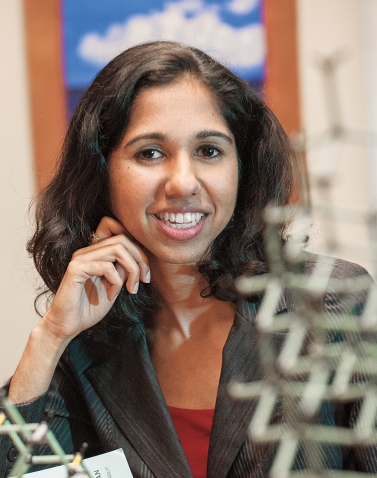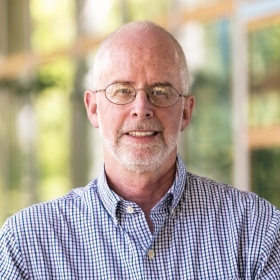Photo by Richard Howard
Over lunch at the Leaky Beaker in the Science Center, we talked with Mala Radhakrishnan, associate professor of chemistry, about poetry, research, and life at Wellesley.
How did you come to the College?
I was really interested in teaching and research. And as a woman in computational science, the sense here of empowering women to think, to really have lots of options, and not feel like they can’t do certain things—that was what drew me. It’s going to be 10 years soon.
What’s it like to be a scientist in a liberal arts institution?
It’s fun. I think my favorite part—and it’s both good and bad—is that I’m kind of the only one on campus who does my thing, which means that if I don’t know the answer to a question, I have to go outside. But one really cool thing about that is that when I go to talks [on campus], they’re hardly ever in my field. It just is so nice to see what other people do. And new projects and collaborations can start from that.
You have a 2-year-old and a 6-year-old. Do you have any time for reading? What’s in your book pile?
Siblings Without Rivalry. I’ve been in the middle of that one for a while.
You’re the author of a poetry book, Atomic Romances, Molecular Dances, that humorously teaches chemical concepts. How did that come about?
Back before grad school, I was in the Boston area for a summer. I had a friend who literally dragged me to a poetry slam at the Cantab Lounge in Central Square. They had an open mic before the slam. We dared each other to write a poem and read one at the open mic. So I wrote a poem. And it had nothing to do with chemistry. I read it, and it was OK. And then I wrote another poem, about Scrabble. I was teaching high-school chemistry at the time. The next summer, I wrote a chemistry-themed poem and read it, and they really, really liked it. So I went every week. I became the chemistry poet, as part of a poetry troupe.
What’s going on with your own research?
I just got funded by the National Science Foundation. We’re taking next steps in a project to understand what makes molecules interact. I like to say that we’re molecular matchmakers. In a cell, it’s very dynamic, but it’s very crowded. How does the presence of all these other molecules affect how two molecules interact? We want to figure out the best way to model them. It’s about our fundamental understanding of how everything works.







We ask that those who engage in Wellesley magazine's online community act with honesty, integrity, and respect. (Remember the honor code, alums?) We reserve the right to remove comments by impersonators or comments that are not civil and relevant to the subject at hand. By posting here, you are permitting Wellesley magazine to edit and republish your comment in all media. Please remember that all posts are public.